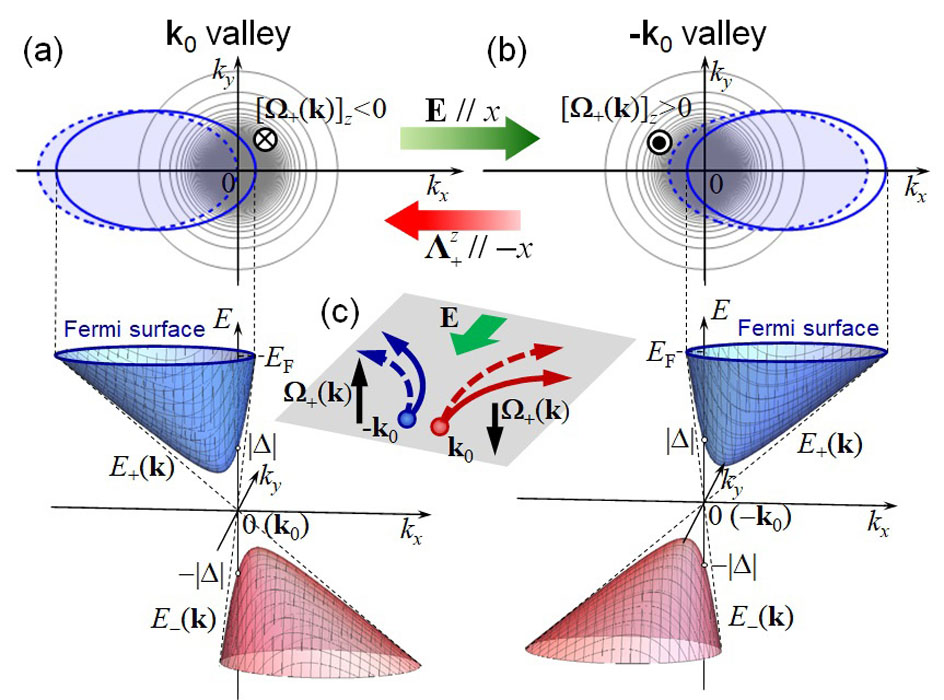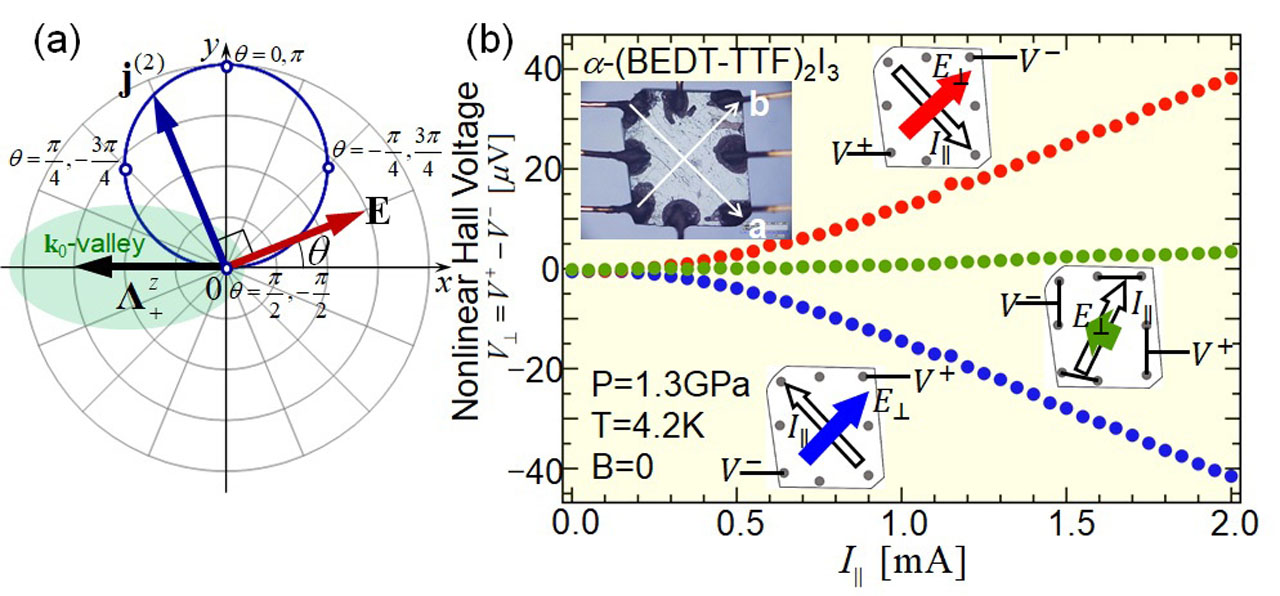Nonlinear Anomalous Hall Effect in Organic Massive Dirac Fermion System
Osada Group
When an electron system has a conduction band with a finite Berry curvature and no time reversal symmetry, it may exhibit the intrinsic anomalous Hall effect (AHE) even at zero magnetic field. This topologically nontrivial transport phenomena disappears in equilibrium state of the system with time reversal symmetry. However, the AHE may revive as a nonlinear transport phenomenon in the non-equilibrium state carrying finite electric current.

Fig. 1. Current-carrying state in the 2D massive DF system with tilted Dirac cones around (a) k0 and (b) -k0. Lower panels depict the band dispersion and upper panels illustrate the Berry curvature (contours) and the Fermi surface of the conduction band. The hatched region indicates occupied states in the current-carrying state. (c) Schematic of the nonlinear AHE. The balance of average anomalous velocity of electrons around k0 and -k0 is broken (dashed arrows) in the current-carrying state.
In this study, we predicted the nonlinear AHE in a layered organic conductor α-(BEDT-TTF)2I3, and confirmed it experimentally. This is the first example of topological transport phenomena in organic conductors. We focused on the "weak" charge ordering (CO) state in α-(BEDT-TTF)2I3, where the inversion symmetry is broken. This compound exhibits a phase transition to a CO insulator at 135 K at ambient pressure. This CO transition is suppressed by pressure, and a two-dimensional (2D) massless Dirac fermion (DF) state appears above the critical pressure Pc ~ 1.3 GPa. The CO state just below Pc is called the weak CO state.
First, we experimentally established the fact that the weak CO state is a 2D massive DF state with a pair of tilted gapped Dirac cones [1]. We used the temperature-dependent peak structure of the interlayer magnetoresistance, which is peculiar to the layered DF system. The magnetic field dependence of the peak temperature observed in the weak CO state is explained only by the massive DF with a finite gap. Therefore, a finite Berry curvature appears in the weak CO state.
Next, we investigated the nonlinear AHE in the current-carrying state in the 2D massive DF system [2]. Under the time reversal symmetry, the sum of Berry curvature over occupied states is canceled out between the Kramers pair of Dirac cones, resulting in no AHE in the equilibrium state. However, if the Dirac cones are tilting, this Berry curvature balance is broken between the Dirac cone pair in the current-carrying state with non-equilibrium distribution. It revives finite AHE as the current-induced nonlinear AHE. The efficiency for the appearance of this current-induced phenomenon is represented by the Berry curvature dipole (BCD) of the system. We demonstrated the anisotropy and rectification characteristics (non-reciprocity) of the nonlinear AHE in the 2D tilted massive DF system. The generated Hall current exhibits unidirectionality even under an external AC field. Furthermore, we quantitatively estimated the nonlinear AHE expected in the weak CO state in α-(BEDT-TTF)2I3, and concluded that it is within the measurable range.
In real α-(BEDT-TTF)2I3, there may exist two types of CO domains, which cancel the nonlinear AHE under current. So, we proposed the "current-field-cooling" technique, for macroscopic emergence of nonlinear AHE [2]. It utilizes the current-induced orbital magnetization (orbital Edelstein effect) to enhance the formation of single type of CO domains.
Finally, we attempted an experimental confirmation of the nonlinear AHE in the weak CO state in α-(BEDT-TTF)2I3. We performed transport measurements in the weak CO state at 1.25 GPa and 4.2 K, and extracted the nonlinear signal from current-reversed data. We successfully observed nonlinear AHE with estimated order and rectifying characteristics only below the CO transition temperature [3].
References
- [1] K. Yoshimura, M. Sato, and T. Osada, J. Phys. Soc. Jpn. 90, 033701 (2021).
- [2] T. Osada and A. Kiswandhi, J. Phys. Soc. Jpn. 89, 103701 (2020); ibid. 128002 (2020).
- [3] A. Kiswandhi and T. Osada, arXiv: 2103.00300.

